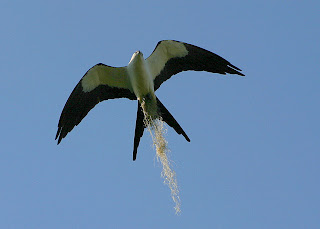Ring Neck Snake Diadophis punctatus punctatus
Seems these guys are on the move recently possibly due to the recent rains. Whilst gathering my equipment for a photo shoot of two of these critters I almost stepped on another small one not quite 4" long. Scooped em up and gave him or her their 15 minutes of fame before letting them go. My daughter wanted to keep a couple as pets but found out how hard collecting food for them was going to be.
Thursday, August 25, 2011
Thursday, July 7, 2011
The lowly Dauben water lily in a new light.
I have been experimenting on a new (or at least new to me) technique. It involves a translucent background lit from the behind as well as balanced foreground light. This really accentuates the subject without any distracting feature. Pretty easy with stationary subjects and really portable enough to take into the field.
 |
| Scarlet Snake |
Saturday, April 2, 2011
Everglades Nat. Park / Pine Glades Lake
Swallow-tailed Kite Elanoides forficatus
South Fl Nature and Wildlife Photography Meetup group outing on March 26, 2011. Here are 2 of a couple photos out of the hundreds taken Sat an Sun. Weather was gorgeous! Probably the last of the tent camping season here in S.FL. unless we get an unseasonably cool April. High temps in the low 80's and night time temps in the low 60's. Perfect! The campground at Long Pine Key was very clean and quiet.
Pine Glades Lake is a man-made borrow pit dug before the park was established. It is about 10-15 acres with a limestone base rock. The water and base rock are nutrient poor limiting plant and algae growth. Therefore visibility is over 6'. Good use of the polarizing filter allows for photos that pierce right into the shallows.
Taken about 30 min after sunset. Natural and LED illumination.
http://www.nps.gov/ever/index.htm
South Fl Nature and Wildlife Photography Meetup group outing on March 26, 2011. Here are 2 of a couple photos out of the hundreds taken Sat an Sun. Weather was gorgeous! Probably the last of the tent camping season here in S.FL. unless we get an unseasonably cool April. High temps in the low 80's and night time temps in the low 60's. Perfect! The campground at Long Pine Key was very clean and quiet.
Everglades National Park was established in 1947 and covers over 1.5 million acres. It is defined by water though now we are in the midst of a record drought making much of the park very dry. Rainfall totals for this dry season are as low as ever recorded in some 80 years. Much of the interior of the park is so dry you can walk through the sawgrasss marsh with out even getting muddy. It is usually covered by 1-3 ft of water.
Taken about 30 min after sunset. Natural and LED illumination.
http://www.nps.gov/ever/index.htm
Subscribe to:
Posts (Atom)



